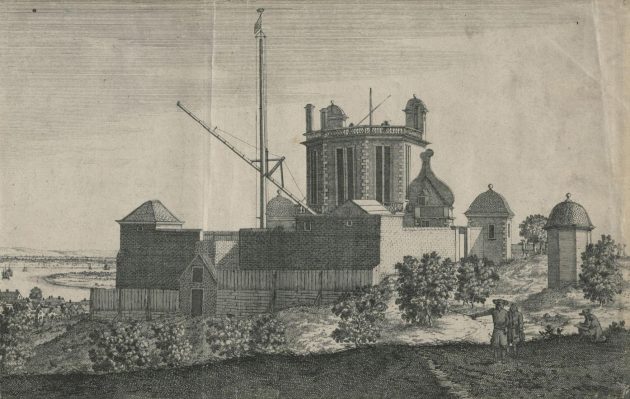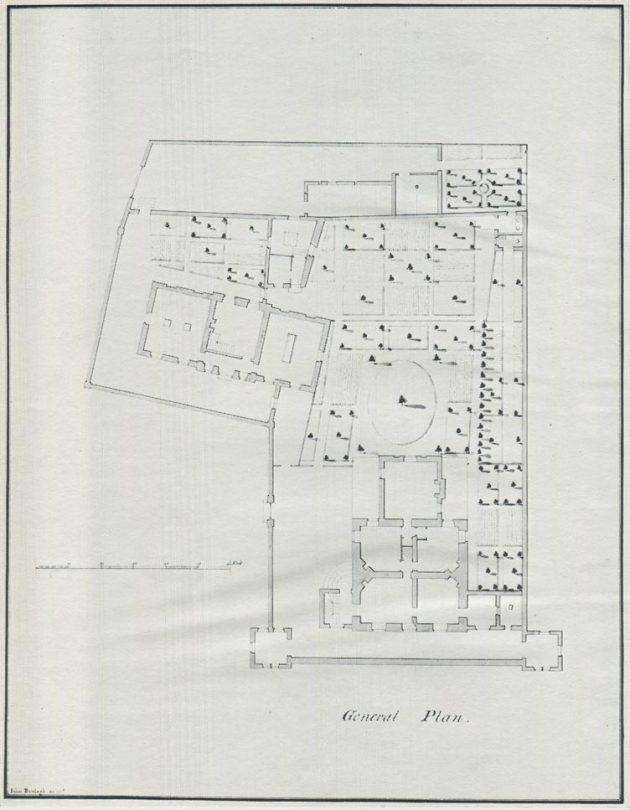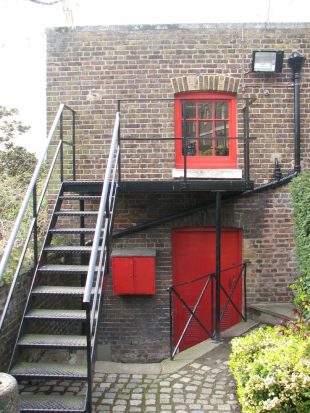…where east meets west
- Home
- Brief History
- The Greenwich Meridian
- Greenwich
(1675–1958) - Herstmonceux
(1948–1990) - Cambridge
(1990–1998) - Outstations (1822–1971)…
- – Chingford (1822–1924)
- – Deal
(1864–1927) - – Abinger
(1923–1957) - – Bristol & Bradford on Avon
(1939–1948) - – Bath
(1939–1949) - – Hartland
(1955–1967) - – Cape of Good Hope
(1959–1971)
- Administration…
- – Funding
- – Governance
- – Inventories
- – Pay
- – Regulations
- – Royal Warrants
- Contemporary Accounts
- People
- Publications
- Science
- Technology
- Telescopes
- Chronometers
- Clocks & Time
- Board of Longitude
- Libraries & Archives
- Visit
- Search
The Garden House/Stables/Plant Room
The origins of the present Plant Room date back to at least the time of Flamsteed. Always a minor auxiliary building, its history is poorly documented. Over the years, it has had a variety of uses, including stabling, as a tool shed and as a garden house. It is not shown on the earliest known plan of the Observatory site, which is that drawn by Flamsteed and sent to Richard Townley on 22 January 1676 while Flamsteed House was still under construction. The famous set of etchings by Francis Place executed soon after, show the presence of a sundial at the centre of the southern boundary with a small Garden Room or potting shed set below it and adjoining the retaining wall of the Observatory enclosure. Access to the Garden Room at that time appears to have been via a subterranean passage (described in the 1950s as a dry brick culvert) that connected to the basement area of Flamsteed House, or directly from the Park. It is not clear in Flamsteed’s time if it consisted of one or two stories. Nor is it clear if it was built specially for Flamsteed, or if it was a relic of the old Greenwich Castle.

The Royal Observatory in Flamsteed's Time. The doorway (bottom left) was the entrance to Flamsteed's garden room / potting shed. Etching by Francis Place after Robert Thacker c.1678 (detail), Digitised by the British Library and released under a Creative Commons Public Domain Mark (No Known Copyright). King George III collection, British Library shelfmark: Maps K.Top.17.1-3.a.1 (see below)
In about 1749, the grounds were extended to facilitate the building of Bradley’s New Observatory. As well as enclosing land to the east, a small strip of land appears to have been enclosed to the south and the Garden Room remodelled either then, or soon after into a stable block containing two stalls for horses. At this point, it had two stories and a pitched roof which only slightly protruded above the lawn at the rear of Flamsteed House. It was accessed via gently sloping ground from the east, at the end of which, there was a pair of double gates into the Park. In the report of the Triangulation carried out by General Roy in 1787 it was probably still in use as stables, but is described as an out-house.

John Evelegh's plan of the Observatory drawn between 1750 and 1773, with north at the bottom. It shows how the grounds were extended eastwards (to the left) and slightly southwards (upwards) to provide space for Bradley's New Observatory and also to allow access to the new stables (top right) that appear to have been created from Flamsteed's garden room / potting shed. From a copy of the plan published in QJRAS in 1963
In about 1789, Bradley’s extension to Flamsteed House was pulled down and replaced with a larger one for Maskelyne. At about the same time, the existing stables were demolished and a larger version built (RGO6/44/11). Instead of the two stalls orientated in a north-south direction, the new stable had three orientated east-west. When the Courtyard was enclosed in 1791, the stables had to be accessed via the new courtyard gates. Once the Meridian Building had been extended in around 1808/1809 and again in 1813, access to the stables with a horse would have become rather more difficult if not impossible. In 1816, the stables were converted into a store room for lumber etc (RGO6/1 f54). A plan dated 1831, shows the building as stables, with its ground floor now extended to the south and divided into three stalls. With Airy’s arrival in 1835, the building took on a new use as a tool shed and the land to its east was landscaped into a formal garden. The external steps descending on its eastern side from the lawn of Flamsteed House were introduced in 1835/6 by Airy whilst Flamsteed House was being extended. A view drawn in 1838 shows that by then the building had its present flat roof, suggesting alterations were made whilst the other works were being carried out in 1835/6. In the plan of 1845, the building is once again described at the Garden House.
After it had been announced that the Observatory was moving to Herstmonceux, the future of the building was in doubt. Although it was on the north half of the site, for which agreement was eventually reached that it should become a museum, the Bailiff of the Park wanted it demolished, and for its site, along with the gardens immediately to the south of the Meridian Building to be incorporated into the Park. The Royal Warrant issued in 1953 formalised the transfer to the Park. When in 1954, detailed plans started to be drawn up to convert Flamsteed House for Museum use, it became apparent that there was nowhere to place a central boiler … except perhaps in the Garden House, which had the added convenience of being connected to Flamsteed House by a Culvert that would be ideal for carrying the pipes (WORK17/374). In 1957 with work soon to start on the conversion of Flamsteed House, plans were put in place to revise the warrant and transfer the Garden Room along with the Terrace Lawn (The Astronomer’s Garden) and possibly the Meridian Garden to the Museum. The draft was not enacted immediately in case other amendments also might be required in the near future. In the event, an alternative location for the boiler was found and plans to revise the Warrant were shelved.Despite the change of plan, the Garden House was not demolished. It later transferred into Museum use, but without any amendment to the Royal Warrant. It is now in use as a boiler room and a plant room. The external metal staircase to the first floor window was added by the Museum as a health and safety measure to facilitate easy evacuation from the upper story.
Image licensing information
The first Francis Place image is reproduced courtesy of the British Library under a Creative Commons Public Domain Mark (No Known Copyright). King George III collection, British Library shelfmark: Maps K.Top.17.1-3.a.1. Link to image as released on Flickr.
© 2014 – 2025 Graham Dolan
Except where indicated, all text and images are the copyright of Graham Dolan
